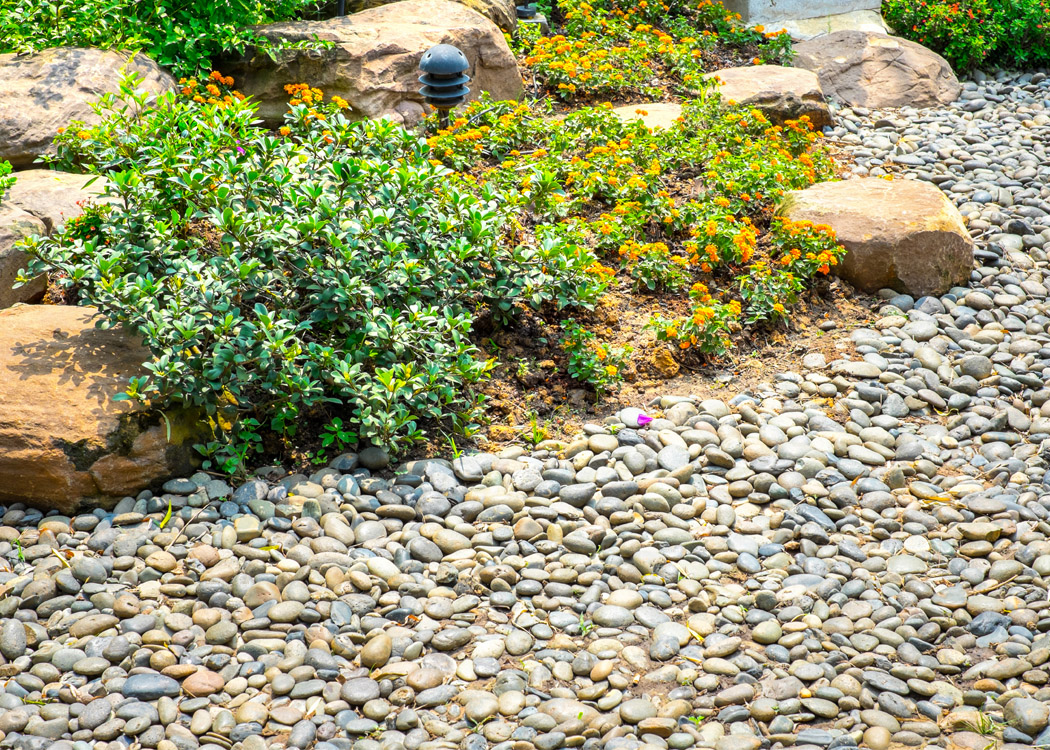Stone setting: the best landscaping techniques
As homeowners, we’re constantly looking for ways to enhance the value and appeal of our home. One timeless way to do this is by strategically laying stones in our landscaping.
Stone not only adds a touch of natural elegance, but also adds texture, depth and character to any outdoor space. However, to ensure a successful and visually pleasing stone setting, you need to know the best techniques!
Here are some techniques, challenges and expert advice for transforming your landscape with stone.
Learn about stone types
First, it’s crucial to understand the different types of stone available. Each variety of stone offers unique characteristics that meet specific aesthetic and functional needs.
Here are some of the types of stone frequently used in landscaping:
Slabs: Stone slabs are large, flat pieces of natural stone that are typically cut and polished for a variety of applications. They are available in a wide range of colours, textures and patterns, making them a popular choice for pool surrounds, walkways, stairs, patios, fireplaces and much more.
Boulders: Boulders are large natural stones that come in a variety of sizes (from a few inches to several feet in diameter), shapes and colours. Boulders add a sense of strength, stability and visual interest to outdoor spaces. They are often used as anchors or functional elements in landscaping.
Natural stone (or river stone): Natural stones are smooth, rounded stones. These stones generally come from riverbeds and are available in different sizes, colours and textures. River stones are a popular choice for landscaping and various decorative purposes because of their natural beauty and versatility..
Groupe Bellemare offers natural stone of the highest quality on the market!
Crushed stone (gravel): Gravel is a versatile type of crushed stone commonly used in landscaping and construction projects. It is composed of small rock fragments and comes in a variety of sizes.
Our quarries produce crushed stone for a wide range of projects.
The importance of analyzing your yard
A successful stone laying project begins with a thorough site analysis. By understanding the characteristics of your land, you can make informed decisions about the stone setting.
Key factors to consider when analyzing the site include:
Sun exposure: Identify areas exposed to direct sunlight, partial shade and full shade to determine appropriate stone choices.
Drainage: Assess water flow paths to avoid potential problems such as flooding or erosion around stones.
Existing vegetation: Work with natural contours and existing vegetation to integrate the stones harmoniously into the landscape.
Functional requirements: Identify the purpose of the stones you wish to add to your landscape. Will they be used to create a fire pit, delimit garden spaces or prevent soil erosion?
Use natural lines
Consider the following principles to guide your arrangement:
Curves: Avoid straight lines, preferring gentle curves to create a natural, relaxed atmosphere.
Respect the topography: Respect the natural contours of the land to ensure that the stones blend harmoniously into their surroundings.
Focal points: Create focal points using larger stones to attract the eye and give a sense of balance and hierarchy.
Strike the right balance
Achieving the right balance in stone setting is crucial for a visually pleasing result.
Symmetry: Symmetrical stone arrangements work wonderfully for more formal landscapes and provide a sense of order.
Asymmetry: For a more relaxed, organic look, opt for asymmetrical stone arrangements. This involves placing stones at varying distances and angles.
Scale and proportion: Select stones that match the scale of your plot to avoid effects that are too striking or too discreet.
Challenges of stone setting
- Weight and safety: Large stones are often very heavy, so always ask for help or contact professionals when handling them.
- Stability: Make sure the stones are properly embedded in the ground. Use gravel or sand as a base to improve stability and prevent shifting over time.
- Winter: Be aware of seasonal changes and the challenges they bring. In winter, freezing, thawing and snowstorms can damage your stones. You’ll also need to take care when clearing snow from your property, whether with a shovel or a snow blower.
- Maintenance: Choose low-maintenance, weather-resistant stones for longevity and appearance.
Expert advice for a successful stone setting
- Overlay: Create depth and dimension by layering stones of different sizes, shapes and colours.
- Contrast: Use contrasting colours and textures to highlight the beauty of individual stones and create an interesting effect.
- Test settings: Before finalizing the installation, experiment with temporary stone layouts to assess their visual impact on your landscape.
- Patience: Stone setting is an art that requires patience and experimentation. Take your time to achieve the desired effect!
Large-scale project? Think stone slinger
Renting a stone slinger is an excellent option for large landscaping projects or difficult-to-access sites. These machines are designed to transport and spread various materials, such as sand, stone, gravel or soil, with precision.
Here are the main advantages of a stone slinger:
- Precise slinging of materials up to 90 feet
- Quick installation with no loss of material
- No breakage of footings, drains or grounds
- Efficient for residential and commercial projects
Contact us to rent a stone slinger.
